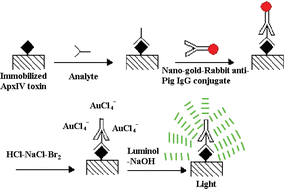Gold(iii) enhanced chemiluminescence immunoassay for detection of antibody against ApxIV of Actinobacillus pleuropneumoniae†‡
Abstract
We report, for the first time, a chemiluminescence immunoassay (CLIA) method based on AuCl4−-enhanced

Maintenance work is planned for Wednesday 1st May 2024 from 9:00am to 11:00am (BST).
During this time, the performance of our website may be affected - searches may run slowly and some pages may be temporarily unavailable. If this happens, please try refreshing your web browser or try waiting two to three minutes before trying again.
We apologise for any inconvenience this might cause and thank you for your patience.
* Corresponding authors
a
College of Science, State Key Laboratory of Agricultural Microbiology, Huazhong Agricultural University, Wuhan, China
E-mail:
hyhan@mail.hzau.edu.cn
Fax: +86 27 87288246
Tel: +86 27 87288246
b Division of Animal Infectious Disease in the State Key Laboratory of Agricultural Microbiology, College of Veterinary Medicine, Huazhong Agricultural University, Wuhan, China
We report, for the first time, a chemiluminescence immunoassay (CLIA) method based on AuCl4−-enhanced

 Please wait while we load your content...
Something went wrong. Try again?
Please wait while we load your content...
Something went wrong. Try again?
D. Hu, H. Han, R. Zhou, F. Dong, W. Bei, F. Jia and H. Chen, Analyst, 2008, 133, 768 DOI: 10.1039/B715476C
To request permission to reproduce material from this article, please go to the Copyright Clearance Center request page.
If you are an author contributing to an RSC publication, you do not need to request permission provided correct acknowledgement is given.
If you are the author of this article, you do not need to request permission to reproduce figures and diagrams provided correct acknowledgement is given. If you want to reproduce the whole article in a third-party publication (excluding your thesis/dissertation for which permission is not required) please go to the Copyright Clearance Center request page.
Read more about how to correctly acknowledge RSC content.
 Fetching data from CrossRef.
Fetching data from CrossRef.
This may take some time to load.
Loading related content
